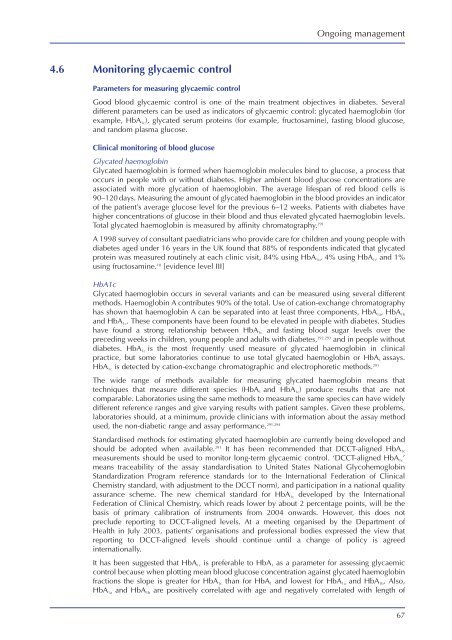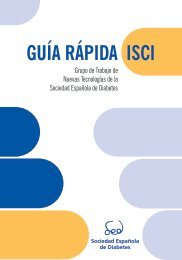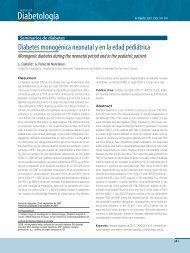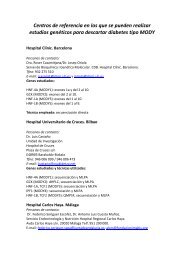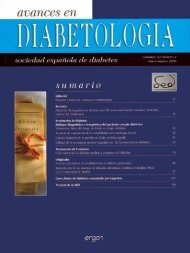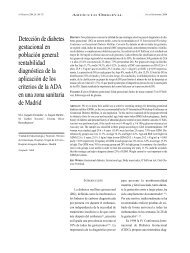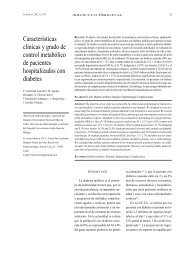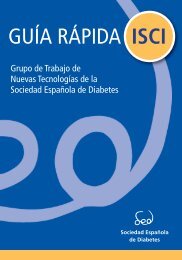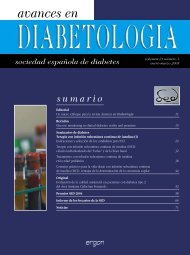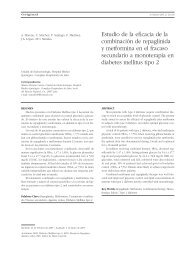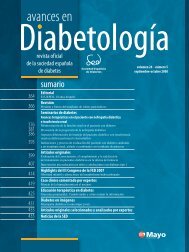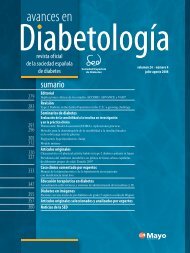You also want an ePaper? Increase the reach of your titles
YUMPU automatically turns print PDFs into web optimized ePapers that Google loves.
Ongoing management4.6 Monitoring glycaemic controlParameters for measuring glycaemic controlGood blood glycaemic control is one of the main treatment objectives in <strong>diabetes</strong>. Severaldifferent parameters can be used as indicators of glycaemic control: glycated haemoglobin (forexample, HbA 1c ), glycated serum proteins (for example, fructosamine), fasting blood glucose,and random plasma glucose.Clinical monitoring of blood glucoseGlycated haemoglobinGlycated haemoglobin is formed when haemoglobin molecules bind to glucose, a process thatoccurs in people with or without <strong>diabetes</strong>. Higher ambient blood glucose concentrations areassociated with more glycation of haemoglobin. The average lifespan of red blood cells is90–120 days. Measuring the amount of glycated haemoglobin in the blood provides an indicatorof the patient’s average glucose level for the previous 6–12 weeks. Patients with <strong>diabetes</strong> havehigher concentrations of glucose in their blood and thus elevated glycated haemoglobin levels.Total glycated haemoglobin is measured by affinity chromatography. 291A 1998 survey of consultant paediatricians who provide care for children and young people with<strong>diabetes</strong> aged under 16 years in the UK found that 88% of respondents indicated that glycatedprotein was measured routinely at each clinic visit, 84% using HbA 1c , 4% using HbA 1 , and 1%using fructosamine. 18 [evidence level III]HbA1cGlycated haemoglobin occurs in several variants and can be measured using several differentmethods. Haemoglobin A contributes 90% of the total. Use of cation-exchange chromatographyhas shown that haemoglobin A can be separated into at least three components, HbA 1a , HbA 1band HbA 1c . These components have been found to be elevated in people with <strong>diabetes</strong>. Studieshave found a strong relationship between HbA 1c and fasting blood sugar levels over thepreceding weeks in children, young people and adults with <strong>diabetes</strong>, 292,293 and in people without<strong>diabetes</strong>. HbA 1c is the most frequently used measure of glycated haemoglobin in clinicalpractice, but some laboratories continue to use total glycated haemoglobin or HbA 1 assays.HbA 1c is detected by cation-exchange chromatographic and electrophoretic methods. 291The wide range of methods available for measuring glycated haemoglobin means thattechniques that measure different species (HbA 1 and HbA 1c ) produce results that are notcomparable. Laboratories using the same methods to measure the same species can have widelydifferent reference ranges and give varying results with patient samples. Given these problems,laboratories should, at a minimum, provide clinicians with information about the assay methodused, the non-diabetic range and assay performance. 291,294Standardised methods for estimating glycated haemoglobin are currently being developed andshould be adopted when available. 291 It has been recommended that DCCT-aligned HbA 1cmeasurements should be used to monitor long-term glycaemic control. ‘DCCT-aligned HbA 1c ’means traceability of the assay standardisation to United States National GlycohemoglobinStandardization Program reference standards (or to the International Federation of ClinicalChemistry standard, with adjustment to the DCCT norm), and participation in a national qualityassurance scheme. The new chemical standard for HbA 1c developed by the InternationalFederation of Clinical Chemistry, which reads lower by about 2 percentage points, will be thebasis of primary calibration of instruments from 2004 onwards. However, this does notpreclude reporting to DCCT-aligned levels. At a meeting organised by the Department ofHealth in July 2003, patients’ organisations and professional bodies expressed the view thatreporting to DCCT-aligned levels should continue until a change of policy is agreedinternationally.It has been suggested that HbA 1c is preferable to HbA 1 as a parameter for assessing glycaemiccontrol because when plotting mean blood glucose concentration against glycated haemoglobinfractions the slope is greater for HbA 1c than for HbA 1 and lowest for HbA 1a and HbA 1b . Also,HbA 1a and HbA 1b are positively correlated with age and negatively correlated with length of67


